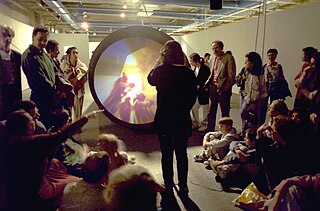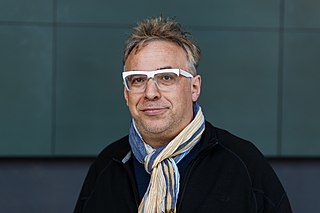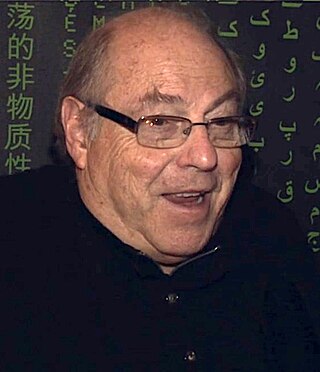
Digital art refers to any artistic work or practice that uses digital technology as part of the creative or presentation process. It can also refer to computational art that uses and engages with digital media.

Interactive art is a form of art that involves the spectator in a way that allows the art to achieve its purpose. Some interactive art installations achieve this by letting the observer walk through, over or around them; others ask the artist or the spectators to become part of the artwork in some way.
Glitch is a genre of electronic music that emerged in the 1990s which is distinguished by the deliberate use of glitch-based audio media and other sonic artifacts.
Software art is a work of art where the creation of software, or concepts from software, play an important role; for example software applications which were created by artists and which were intended as artworks. As an artistic discipline software art has attained growing attention since the late 1990s. It is closely related to Internet art since it often relies on the Internet, most notably the World Wide Web, for dissemination and critical discussion of the works. Art festivals such as FILE Electronic Language International Festival, Transmediale (Berlin), Prix Ars Electronica (Linz) and readme have devoted considerable attention to the medium and through this have helped to bring software art to a wider audience of theorists and academics.

Electronic art is a form of art that makes use of electronic media. More broadly, it refers to technology and/or electronic media. It is related to information art, new media art, video art, digital art, interactive art, internet art, and electronic music. It is considered an outgrowth of conceptual art and systems art.
Information art, which is also known as informatism or data art, is an art form that is inspired by and principally incorporates data, computer science, information technology, artificial intelligence, and related data-driven fields. The information revolution has resulted in over-abundant data that are critical in a wide range of areas, from the Internet to healthcare systems. Related to conceptual art, electronic art and new media art, informatism considers this new technological, economical, and cultural paradigm shift, such that artworks may provide social commentaries, synthesize multiple disciplines, and develop new aesthetics. Realization of information art often take, although not necessarily, interdisciplinary and multidisciplinary approaches incorporating visual, audio, data analysis, performance, and others. Furthermore, physical and virtual installations involving informatism often provide human-computer interaction that generate artistic contents based on the processing of large amounts of data.

Lev Manovich is an artist, an author and a theorist of digital culture. He is a Distinguished Professor at the Graduate Center of the City University of New York. Manovich played a key role in creating four new research fields: new media studies (1991-), software studies (2001-), cultural analytics (2007-) and AI aesthetics (2018-). Manovich's current research focuses on generative media, AI culture, digital art, and media theory.

Experiments in Art and Technology (E.A.T.), a non-profit and tax-exempt organization, was established in 1967 to develop collaborations between artists and engineers. The group operated by facilitating person-to-person contacts between artists and engineers, rather than defining a formal process for cooperation. E.A.T. initiated and carried out projects that expanded the role of the artist in contemporary society and helped explore the separation of the individual from technological change.

Roy Ascott FRSA is a British artist, who works with cybernetics and telematics on an art he calls technoetics by focusing on the impact of digital and telecommunications networks on consciousness. Since the 1960s, Ascott has been a practitioner of interactive computer art, electronic art, cybernetic art and telematic art.

Rebecca Allen is an internationally recognized digital artist inspired by the aesthetics of motion, the study of perception and behavior and the potential of advanced technology. Her artwork, which spans four decades and takes the form of experimental video, large-scale performances, live simulations and virtual and augmented reality art installations, addresses issues of gender, identity and what it means to be human as technology redefines our sense of reality.

Maurice Benayoun is a French new-media artist, curator, and theorist based in Paris and Hong Kong.

Virtual art is a term for the virtualization of art, made with the technical media developed at the end of the 1980s. These include human-machine interfaces such as visualization casks, stereoscopic spectacles and screens, digital painting and sculpture, generators of three-dimensional sound, data gloves, data clothes, position sensors, tactile and power feed-back systems, etc. As virtual art covers such a wide array of mediums it is a catch-all term for specific focuses within it. Much contemporary art has become, in Frank Popper's terms, virtualized.

David Avraham Spektor, also spelled Schpektor (9 Av 5715 – 12 Tishrei 5774) was a Dutch–born Israeli rabbi. He was born in Amsterdam, the Netherlands and emigrated to Israel in 1973, after the Yom Kippur war. Spektor studied at several yeshivas for ten years, primarily at Yeshivat Mercaz HaRav and the Meretz Kollel. He was ordained by the Chief Rabbinate of Israel as both a neighbourhood rabbi and city rabbi.

Mel Alexenberg is an American-Israeli artist, art educator, and writer recognized for his pioneering work exploring the intersections of art, science, technology and digital culture. He created the first digital computer generated painting in 1965, experimental digital fine art prints in the 1980s that are in 30 museum collections worldwide, circumglobal cyberangel flights honoring Rembrandt in 1989 and in 2019.
Telematic art is a descriptive of art projects using computer-mediated telecommunications networks as their medium. Telematic art challenges the traditional relationship between active viewing subjects and passive art objects by creating interactive, behavioural contexts for remote aesthetic encounters. Telematics was first coined by Simon Nora and Alain Minc in The Computerization of Society. Roy Ascott sees the telematic art form as the transformation of the viewer into an active participator of creating the artwork which remains in process throughout its duration. Ascott has been at the forefront of the theory and practice of telematic art since 1978 when he went online for the first time, organizing different collaborative online projects.
Communication Aesthetics is a theory devised by Mario Costa and Fred Forest at Mercato San Severino in Italy in 1983. It is a theory of aesthetics calling for artistic practice engaging with and working through the developments, evolutions and paradigms of late twentieth century communications technologies. Observing the emerging supremacy of networks over subjects, it called for an artistic approach that was both adapted to, and invested in this changing techno-social arena.

Dominique Moulon is a historian of art and technology, art critic and curator, specializing in French digital art. He is the author of the books Art contemporain nouveaux médias and Art Beyond Digital.

Maurizio Bolognini is a post-conceptual media artist. His installations are mainly concerned with the aesthetics of machines, and are based on the minimal and abstract activation of technological processes that are beyond the artist's control, at the intersection of generative art, public art and e-democracy.

New media art includes artworks designed and produced by means of electronic media technologies, comprising virtual art, computer graphics, computer animation, digital art, interactive art, sound art, Internet art, video games, robotics, 3D printing, and cyborg art. The term defines itself by the thereby created artwork, which differentiates itself from that deriving from conventional visual arts. New Media art has origins in the worlds of science, art, and performance. Some common themes found in new media art include databases, political and social activism, Afrofuturism, feminism, and identity, a ubiquitous theme found throughout is the incorporation of new technology into the work. The emphasis on medium is a defining feature of much contemporary art and many art schools and major universities now offer majors in "New Genres" or "New Media" and a growing number of graduate programs have emerged internationally. New media art may involve degrees of interaction between artwork and observer or between the artist and the public, as is the case in performance art. Yet, as several theorists and curators have noted, such forms of interaction, social exchange, participation, and transformation do not distinguish new media art but rather serve as a common ground that has parallels in other strands of contemporary art practice. Such insights emphasize the forms of cultural practice that arise concurrently with emerging technological platforms, and question the focus on technological media per se. New Media art involves complex curation and preservation practices that make collecting, installing, and exhibiting the works harder than most other mediums. Many cultural centers and museums have been established to cater to the advanced needs of new media art.

Glitch art is the practice of using digital or analog errors for aesthetic purposes by either corrupting digital data or physically manipulating electronic devices. Glitches appear in visual art such as the film A Colour Box (1935) by Len Lye, the video sculpture TV Magnet (1965) by Nam June Paik and more contemporary work such as Panasonic TH-42PWD8UK Plasma Screen Burn (2007) by Cory Arcangel.














